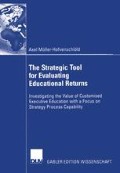Abstract
The success or failure of corporations in today’s global economy depends on many individual, organisational and environmental variables. However, one of the most important factors for sustaining competitive success are the people in an organisation. Practitioners and academics alike agree, that intellectual capital has become the new basis for competition in the post-capitalist society (Drucker 1993). Individual and organisational knowledge plays thus a central role in building competitive advantage (Hamel & Prahalad 1994b). The ability to learn and to un-learn has become a critical — if not the most important — factor for ensuring corporate success in a world of growing complexity and ever faster technological changes (Argyris & Schön 1978; Senge 1990; Davenport & Prusak 1998).
“In the 21st century, the education and skills of the workforce will end up being the dominant competitive weapon.”
(Thurow 1992, p. 275)
Access this chapter
Tax calculation will be finalised at checkout
Purchases are for personal use only
Preview
Unable to display preview. Download preview PDF.
References
The “Computer Age” began in the mid 1970s and lasted until the arrival of the internet in the mid 1990s.
The “Internet Age” started in the mid 1990s and has lasted until today.
For example, 93 per cent of all training professionals at the 1996 ASTD International Conference stated that they are facing increased pressures to demonstrate return-on-investment results (Bassi & McMurrer 1999, p.1).
Rights and permissions
Copyright information
© 2004 Deutscher Universitäts-Verlag/GWV Fachverlage GmbH, Wiesbaden
About this chapter
Cite this chapter
Müller-Hofvenschiöld, A. (2004). Introduction and Overview. In: The Strategic Tool for Evaluating Educational Returns. Deutscher Universitätsverlag. https://doi.org/10.1007/978-3-322-81857-7_1
Download citation
DOI: https://doi.org/10.1007/978-3-322-81857-7_1
Publisher Name: Deutscher Universitätsverlag
Print ISBN: 978-3-8244-8220-7
Online ISBN: 978-3-322-81857-7
eBook Packages: Springer Book Archive

